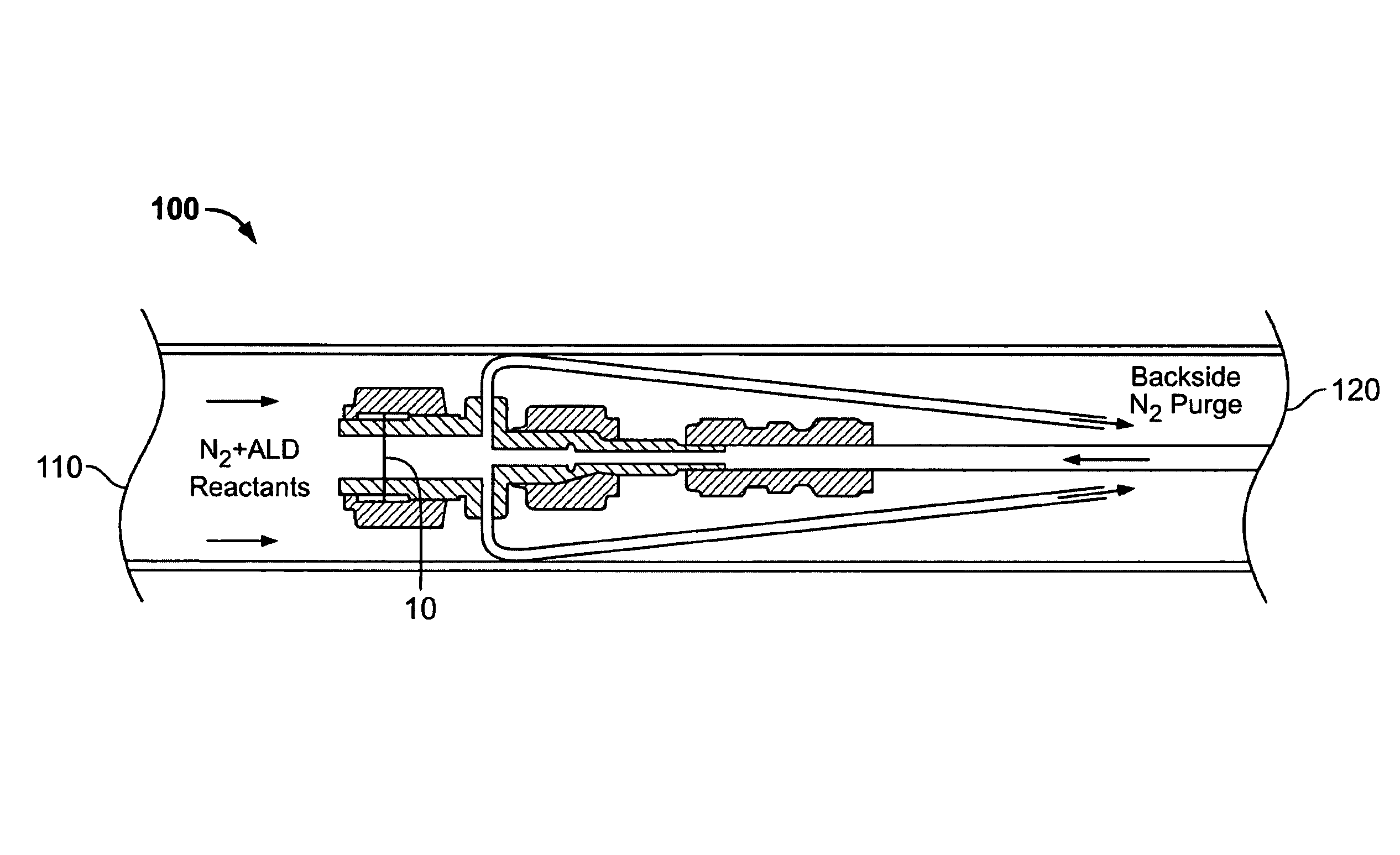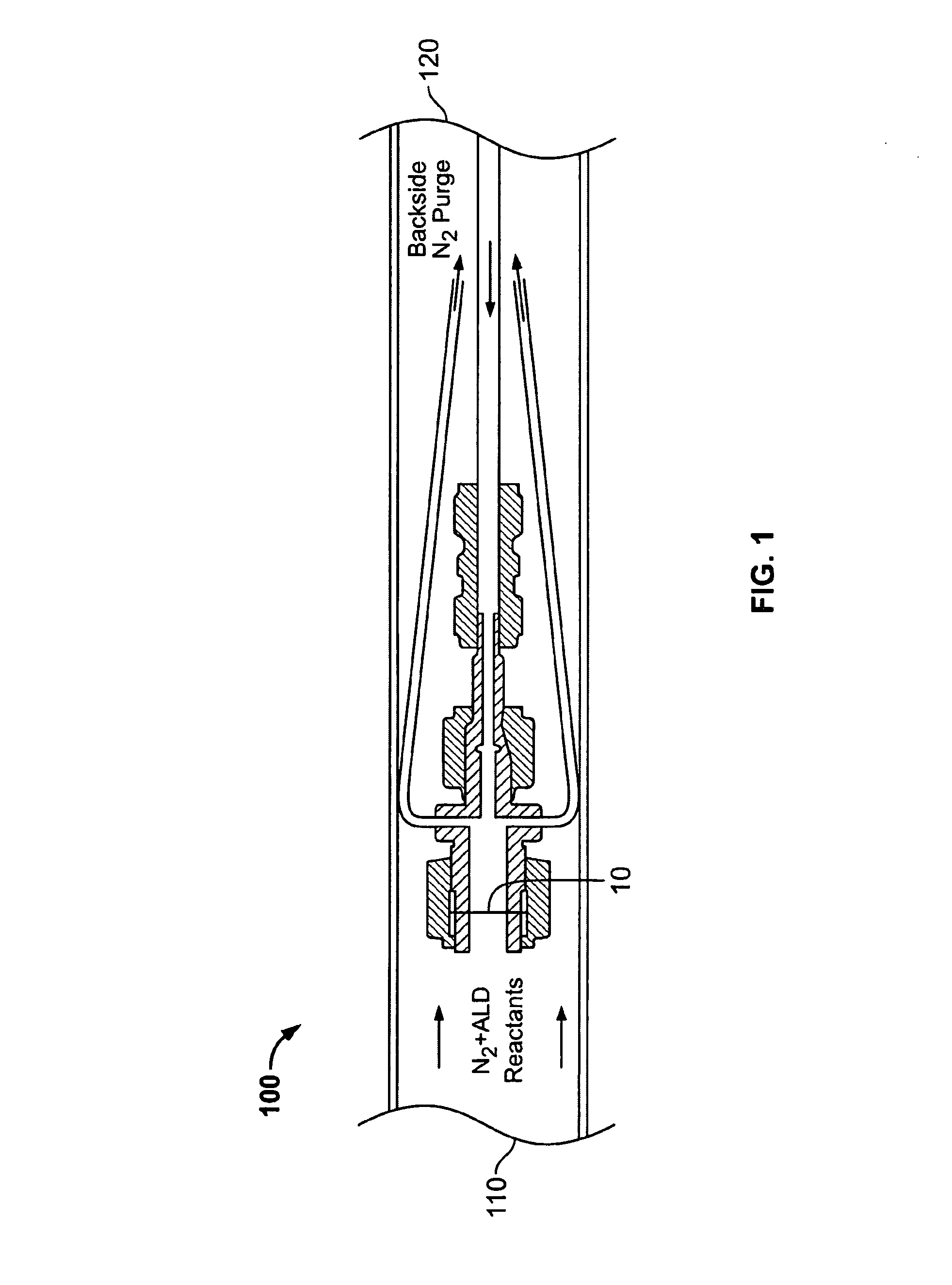Spatially controlled atomic layer deposition in porous materials
a technology of porous materials and atomic layers, which is applied in the direction of catalyst activation/preparation, physical/chemical process catalysts, coatings, etc., can solve the problems of limited technique to deposited mask patterns on flat surfaces, and limited technique to planar substrates
- Summary
- Abstract
- Description
- Claims
- Application Information
AI Technical Summary
Benefits of technology
Problems solved by technology
Method used
Image
Examples
example 1
Preparation of AAO Membrane Samples
[0036]The AAO membranes 10 were prepared by the electrochemical anodization of high purity aluminum metal disks. The disks had a thickness of 0.6 mm and a diameter of 19 mm. A two-step anodization procedure was performed in 0.3 M oxalic acid at 40 V to obtain well-ordered pore arrays in the disks. Boundary layer removal was accomplished using phosphoric acid. As illustrated in FIG. 2A, a masking process employed during the anodization and boundary layer removal steps allowed a free-standing AAO membrane to be fabricated, attached about its perimeter to the starting thickness of aluminum. A gas-tight seal in the viscous flow reactor 100 was applied to the resulting samples using commercial VCR® face-seal fittings. The resulting AAO membranes 10, depicted in FIG. 2B, were 10 mm in diameter and had a thickness of about 70 μm to 75 μm. Analysis of the AAO membranes 10, using scanning electron microscopy (“SEM”), revealed an average pore diameter of 56 ...
example 2
Monte Carlo Simulation
[0038]Monte Carlo simulations were performed to evaluate the EDAX measurements obtained from the AAO membranes. These simulations modeled the AAO pores as a one-dimensional array, and simulated the ALD stripe-coating experiments by following the trajectories of individual TMA and DEZ molecules diffusing along the nanopores. Knudsen diffusion was assumed because the mean free path of the DEZ molecules in 1 Torr N2, about 50 μm, is much greater than the AAO pore diameter, about 50 nm. Consequently, the diffusion was simulated as a one-dimensional random walk of hop-length D, the local pore diameter. After each hop, if the molecule encountered an empty site, the molecule would react with probability equal to the reactive sticking coefficient, 10−3. Each trajectory continued until the molecule reacted or left the tube, and the number of trajectories was selected to model the experimental exposure times and the pressures of DEZ and TMA, respectively. The H2O exposur...
example 3
Formation of ZnO Surface Stripes in AAO
[0039]A stripe of ZnO was formed at the surface edge of the AAO membrane 10 by applying 60 cycles of DEZ / H2O with the timing sequence 1-10-1-10. The results achieved by this process are illustrated in FIGS. 5A, 5B and 5C. The DEZ and H2O exposure times were chosen to be sub-saturating so that the precursors would not completely infiltrate the nanopores. Following the deposition, the AAO membrane 10 was cleaved, and a cross-sectional specimen was analyzed by SEM and EDAX. FIG. 5A shows a SEM secondary electron image of the sample. The location of the back side of the membrane is indicated by the interface between the silver epoxy and the AAO membrane 10. FIG. 5B shows an EDAX map of the distribution of Zn in the sample as monitored by the Zn Lα line. The z-axis in FIG. 5B is aligned substantially parallel to the AAO pores. The Zn penetrates approximately 8 microns into the AAO membrane 10 as shown in FIG. 5B.
[0040]FIG. 5C shows a linescan of the...
PUM
| Property | Measurement | Unit |
|---|---|---|
| aspect ratio | aaaaa | aaaaa |
| pressure | aaaaa | aaaaa |
| diameter | aaaaa | aaaaa |
Abstract
Description
Claims
Application Information
 Login to View More
Login to View More - R&D
- Intellectual Property
- Life Sciences
- Materials
- Tech Scout
- Unparalleled Data Quality
- Higher Quality Content
- 60% Fewer Hallucinations
Browse by: Latest US Patents, China's latest patents, Technical Efficacy Thesaurus, Application Domain, Technology Topic, Popular Technical Reports.
© 2025 PatSnap. All rights reserved.Legal|Privacy policy|Modern Slavery Act Transparency Statement|Sitemap|About US| Contact US: help@patsnap.com



